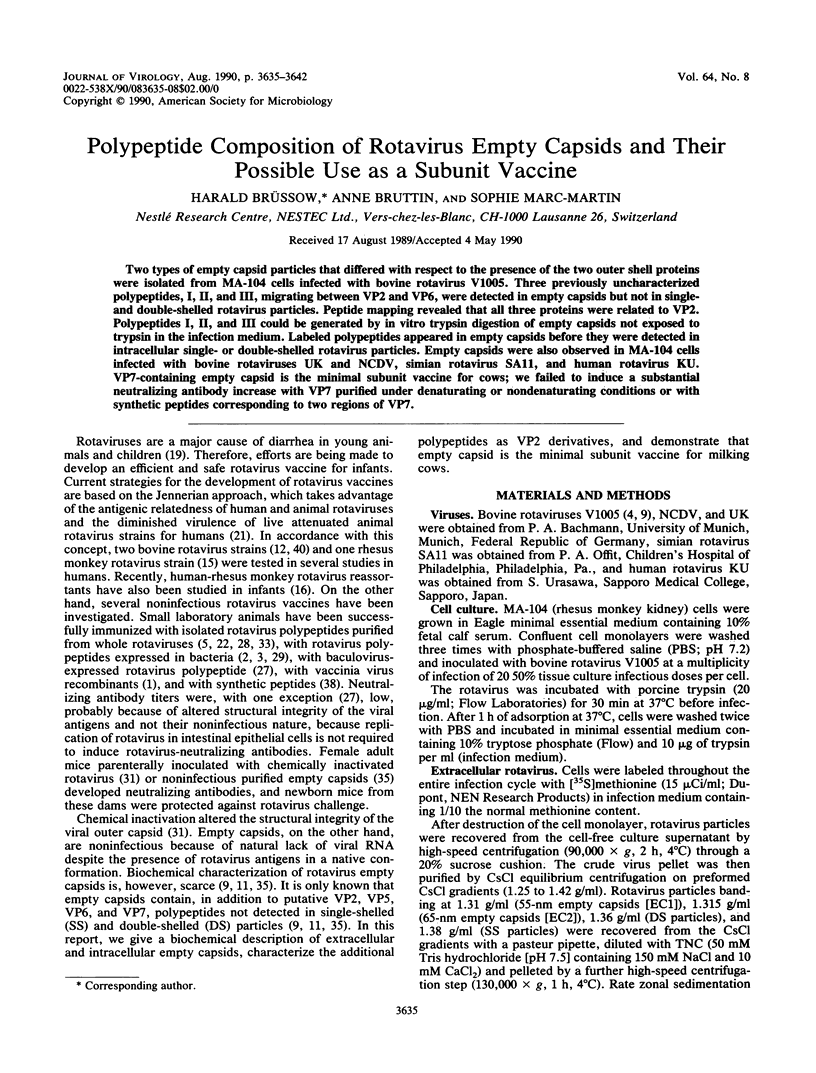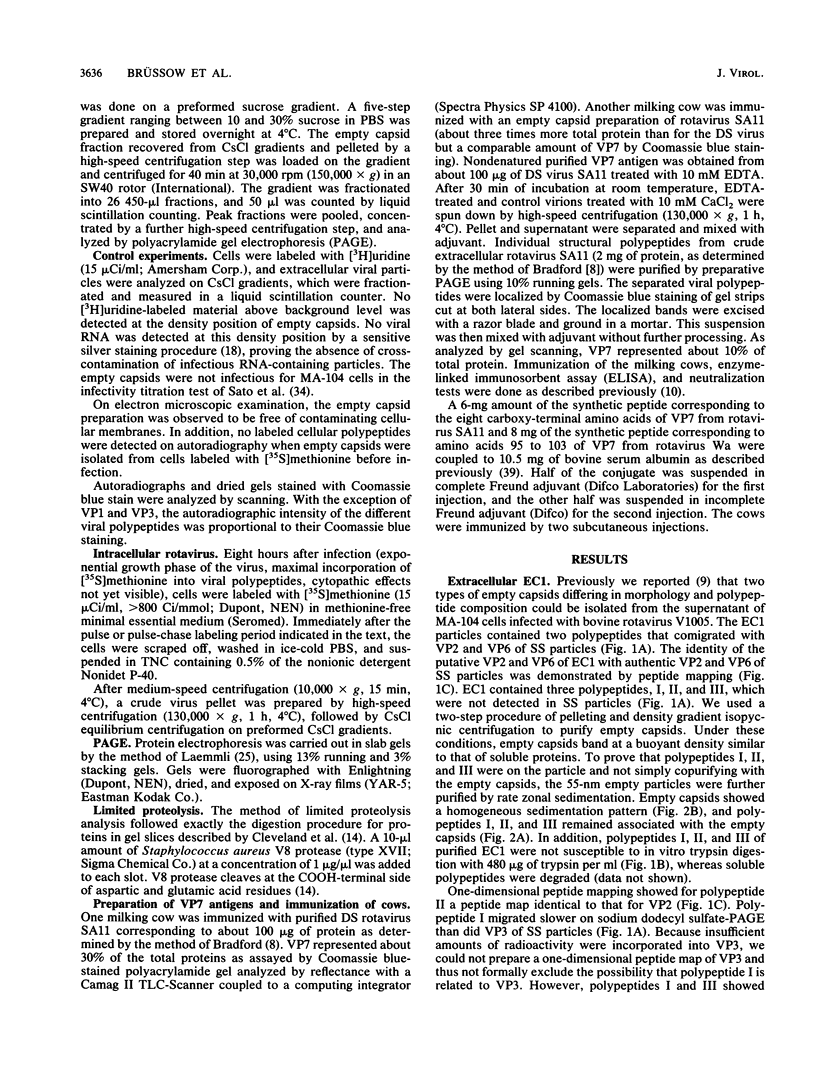Abstract
Two types of empty capsid particles that differed with respect to the presence of the two outer shell proteins were isolated from MA-104 cells infected with bovine rotavirus V1005. Three previously uncharacterized polypeptides, I, II, and III, migrating between VP2 and VP6, were detected in empty capsids but not in single- and double-shelled rotavirus particles. Peptide mapping revealed that all three proteins were related to VP2. Polypeptides I, II, and III could be generated by in vitro trypsin digestion of empty capsids not exposed to trypsin in the infection medium. Labeled polypeptides appeared in empty capsids before they were detected in intracellular single- or double-shelled rotavirus particles. Empty capsids were also observed in MA-104 cells infected with bovine rotaviruses UK and NCDV, simian rotavirus SA11, and human rotavirus KU. VP7-containing empty capsid is the minimal subunit vaccine for cows; we failed to induce a substantial neutralizing antibody increase with VP7 purified under denaturating or nondenaturating conditions or with synthetic peptides corresponding to two regions of VP7.
Full text
PDF







Images in this article
Selected References
These references are in PubMed. This may not be the complete list of references from this article.
- Andrew M. E., Boyle D. B., Coupar B. E., Whitfeld P. L., Both G. W., Bellamy A. R. Vaccinia virus recombinants expressing the SA11 rotavirus VP7 glycoprotein gene induce serotype-specific neutralizing antibodies. J Virol. 1987 Apr;61(4):1054–1060. doi: 10.1128/jvi.61.4.1054-1060.1987. [DOI] [PMC free article] [PubMed] [Google Scholar]
- Arias C. F., Ballado T., Plebañski M. Synthesis of the outer-capsid glycoprotein of the simian rotavirus SA11 in Escherichia coli. Gene. 1986;47(2-3):211–219. doi: 10.1016/0378-1119(86)90065-x. [DOI] [PubMed] [Google Scholar]
- Arias C. F., Lizano M., López S. Synthesis in Escherichia coli and immunological characterization of a polypeptide containing the cleavage sites associated with trypsin enhancement of rotavirus SA11 infectivity. J Gen Virol. 1987 Mar;68(Pt 3):633–642. doi: 10.1099/0022-1317-68-3-633. [DOI] [PubMed] [Google Scholar]
- Bachmann P. A., Hess R. G. Routine isolation and cultivation of bovine rotaviruses in cell culture. Am J Vet Res. 1981 Dec;42(12):2149–2150. [PubMed] [Google Scholar]
- Bastardo J. W., McKimm-Breschkin J. L., Sonza S., Mercer L. D., Holmes I. H. Preparation and characterization of antisera to electrophoretically purified SA11 virus polypeptides. Infect Immun. 1981 Dec;34(3):641–647. doi: 10.1128/iai.34.3.641-647.1981. [DOI] [PMC free article] [PubMed] [Google Scholar]
- Bican P., Cohen J., Charpilienne A., Scherrer R. Purification and characterization of bovine rotavirus cores. J Virol. 1982 Sep;43(3):1113–1117. doi: 10.1128/jvi.43.3.1113-1117.1982. [DOI] [PMC free article] [PubMed] [Google Scholar]
- Boyle J. F., Holmes K. V. RNA-binding proteins of bovine rotavirus. J Virol. 1986 May;58(2):561–568. doi: 10.1128/jvi.58.2.561-568.1986. [DOI] [PMC free article] [PubMed] [Google Scholar]
- Bradford M. M. A rapid and sensitive method for the quantitation of microgram quantities of protein utilizing the principle of protein-dye binding. Anal Biochem. 1976 May 7;72:248–254. doi: 10.1006/abio.1976.9999. [DOI] [PubMed] [Google Scholar]
- Brüssow H., Marc-Martin S., Eichhorn W., Sidoti J., Fryder V. Characterization of a second bovine rotavirus serotype. Arch Virol. 1987;94(1-2):29–41. doi: 10.1007/BF01313723. [DOI] [PubMed] [Google Scholar]
- Brüssow H., Walther I., Fryder V., Sidoti J., Bruttin A. Cross-neutralizing antibodies induced by single serotype vaccination of cows with rotavirus. J Gen Virol. 1988 Jul;69(Pt 7):1647–1658. doi: 10.1099/0022-1317-69-7-1647. [DOI] [PubMed] [Google Scholar]
- Clark B., Desselberger U. Myristylation of rotavirus proteins. J Gen Virol. 1988 Oct;69(Pt 10):2681–2686. doi: 10.1099/0022-1317-69-10-2681. [DOI] [PubMed] [Google Scholar]
- Clark H. F., Borian F. E., Bell L. M., Modesto K., Gouvea V., Plotkin S. A. Protective effect of WC3 vaccine against rotavirus diarrhea in infants during a predominantly serotype 1 rotavirus season. J Infect Dis. 1988 Sep;158(3):570–587. doi: 10.1093/infdis/158.3.570. [DOI] [PMC free article] [PubMed] [Google Scholar]
- Clark S. M., Roth J. R., Clark M. L., Barnett B. B., Spendlove R. S. Trypsin enhancement of rotavirus infectivity: mechanism of enhancement. J Virol. 1981 Sep;39(3):816–822. doi: 10.1128/jvi.39.3.816-822.1981. [DOI] [PMC free article] [PubMed] [Google Scholar]
- Cleveland D. W., Fischer S. G., Kirschner M. W., Laemmli U. K. Peptide mapping by limited proteolysis in sodium dodecyl sulfate and analysis by gel electrophoresis. J Biol Chem. 1977 Feb 10;252(3):1102–1106. [PubMed] [Google Scholar]
- Flores J., Perez-Schael I., Blanco M., Vilar M., Garcia D., Perez M., Daoud N., Midthun K., Kapikian A. Z. Reactions to and antigenicity of two human-rhesus rotavirus reassortant vaccine candidates of serotypes 1 and 2 in Venezuelan infants. J Clin Microbiol. 1989 Mar;27(3):512–518. doi: 10.1128/jcm.27.3.512-518.1989. [DOI] [PMC free article] [PubMed] [Google Scholar]
- Flores J., Perez-Schael I., Gonzalez M., Garcia D., Perez M., Daoud N., Cunto W., Chanock R. M., Kapikian A. Z. Protection against severe rotavirus diarrhoea by rhesus rotavirus vaccine in Venezuelan infants. Lancet. 1987 Apr 18;1(8538):882–884. doi: 10.1016/s0140-6736(87)92858-3. [DOI] [PubMed] [Google Scholar]
- Gallegos C. O., Patton J. T. Characterization of rotavirus replication intermediates: a model for the assembly of single-shelled particles. Virology. 1989 Oct;172(2):616–627. doi: 10.1016/0042-6822(89)90204-3. [DOI] [PubMed] [Google Scholar]
- Herring A. J., Inglis N. F., Ojeh C. K., Snodgrass D. R., Menzies J. D. Rapid diagnosis of rotavirus infection by direct detection of viral nucleic acid in silver-stained polyacrylamide gels. J Clin Microbiol. 1982 Sep;16(3):473–477. doi: 10.1128/jcm.16.3.473-477.1982. [DOI] [PMC free article] [PubMed] [Google Scholar]
- Kabcenell A. K., Poruchynsky M. S., Bellamy A. R., Greenberg H. B., Atkinson P. H. Two forms of VP7 are involved in assembly of SA11 rotavirus in endoplasmic reticulum. J Virol. 1988 Aug;62(8):2929–2941. doi: 10.1128/jvi.62.8.2929-2941.1988. [DOI] [PMC free article] [PubMed] [Google Scholar]
- Kapikian A. Z., Flores J., Hoshino Y., Glass R. I., Midthun K., Gorziglia M., Chanock R. M. Rotavirus: the major etiologic agent of severe infantile diarrhea may be controllable by a "Jennerian" approach to vaccination. J Infect Dis. 1986 May;153(5):815–822. doi: 10.1093/infdis/153.5.815. [DOI] [PubMed] [Google Scholar]
- Killen H. M., Dimmock N. J. Identification of a neutralization-specific antigen of a calf rotavirus. J Gen Virol. 1982 Oct;62(Pt 2):297–311. doi: 10.1099/0022-1317-62-2-297. [DOI] [PubMed] [Google Scholar]
- Kozak M. Point mutations define a sequence flanking the AUG initiator codon that modulates translation by eukaryotic ribosomes. Cell. 1986 Jan 31;44(2):283–292. doi: 10.1016/0092-8674(86)90762-2. [DOI] [PubMed] [Google Scholar]
- Kumar A., Charpilienne A., Cohen J. Nucleotide sequence of the gene encoding for the RNA binding protein (VP2) of RF bovine rotavirus. Nucleic Acids Res. 1989 Mar 11;17(5):2126–2126. doi: 10.1093/nar/17.5.2126. [DOI] [PMC free article] [PubMed] [Google Scholar]
- Liu M., Offit P. A., Estes M. K. Identification of the simian rotavirus SA11 genome segment 3 product. Virology. 1988 Mar;163(1):26–32. doi: 10.1016/0042-6822(88)90230-9. [DOI] [PubMed] [Google Scholar]
- Mackow E. R., Vo P. T., Broome R., Bass D., Greenberg H. B. Immunization with baculovirus-expressed VP4 protein passively protects against simian and murine rotavirus challenge. J Virol. 1990 Apr;64(4):1698–1703. doi: 10.1128/jvi.64.4.1698-1703.1990. [DOI] [PMC free article] [PubMed] [Google Scholar]
- Matsuno S., Inouye S. Purification of an outer capsid glycoprotein of neonatal calf diarrhea virus and preparation of its antisera. Infect Immun. 1983 Jan;39(1):155–158. doi: 10.1128/iai.39.1.155-158.1983. [DOI] [PMC free article] [PubMed] [Google Scholar]
- McCrae M. A., McCorquodale J. G. Expression of a major bovine rotavirus neutralisation antigen (VP7c) in Escherichia coli. Gene. 1987;55(1):9–18. doi: 10.1016/0378-1119(87)90243-5. [DOI] [PubMed] [Google Scholar]
- Musalem C., Espejo R. T. Release of progeny virus from cells infected with simian rotavirus SA11. J Gen Virol. 1985 Dec;66(Pt 12):2715–2724. doi: 10.1099/0022-1317-66-12-2715. [DOI] [PubMed] [Google Scholar]
- Offit P. A., Dudzik K. I. Noninfectious rotavirus (strain RRV) induces an immune response in mice which protects against rotavirus challenge. J Clin Microbiol. 1989 May;27(5):885–888. doi: 10.1128/jcm.27.5.885-888.1989. [DOI] [PMC free article] [PubMed] [Google Scholar]
- Ready K. F., Sabara M. In vitro assembly of bovine rotavirus nucleocapsid protein. Virology. 1987 Mar;157(1):189–198. doi: 10.1016/0042-6822(87)90328-x. [DOI] [PubMed] [Google Scholar]
- Sabara M., Barrington A., Babiuk L. A. Immunogenicity of a bovine rotavirus glycoprotein fragment. J Virol. 1985 Dec;56(3):1037–1040. doi: 10.1128/jvi.56.3.1037-1040.1985. [DOI] [PMC free article] [PubMed] [Google Scholar]
- Sato K., Inaba Y., Miura Y., Tokuhisa S., Matumoto M. Antigenic relationships between rotaviruses from different species as studied by neutralization and immunofluorescence. Arch Virol. 1982;73(1):45–50. doi: 10.1007/BF01341726. [DOI] [PubMed] [Google Scholar]
- Sheridan J. F., Smith C. C., Manak M. M., Aurelian L. Prevention of rotavirus-induced diarrhea in neonatal mice born to dams immunized with empty capsids of simian rotavirus SA-11. J Infect Dis. 1984 Mar;149(3):434–438. doi: 10.1093/infdis/149.3.434. [DOI] [PubMed] [Google Scholar]
- Snodgrass D. R., Fahey K. J., Wells P. W., Campbell I., Whitelaw A. Passive immunity in calf rotavirus infections: maternal vaccination increases and prolongs immunoglobulin G1 antibody secretion in milk. Infect Immun. 1980 May;28(2):344–349. doi: 10.1128/iai.28.2.344-349.1980. [DOI] [PMC free article] [PubMed] [Google Scholar]
- Soler C., Musalem C., Loroño M., Espejo R. T. Association of viral particles and viral proteins with membranes in SA11-infected cells. J Virol. 1982 Dec;44(3):983–992. doi: 10.1128/jvi.44.3.983-992.1982. [DOI] [PMC free article] [PubMed] [Google Scholar]
- Streckert H. J., Brüssow H., Werchau H. A synthetic peptide corresponding to the cleavage region of VP3 from rotavirus SA11 induces neutralizing antibodies. J Virol. 1988 Nov;62(11):4265–4269. doi: 10.1128/jvi.62.11.4265-4269.1988. [DOI] [PMC free article] [PubMed] [Google Scholar]
- Streckert H. J., Grunert B., Werchau H. Antibodies specific for the carboxy-terminal region of the major surface glycoprotein of simian rotavirus (SA11) and human rotavirus (Wa). J Cell Biochem. 1986;30(1):41–49. doi: 10.1002/jcb.240300106. [DOI] [PubMed] [Google Scholar]
- Vesikari T., Isolauri E., Delem A., d'Hondt E., André F. E., Beards G. M., Flewett T. H. Clinical efficacy of the RIT 4237 live attenuated bovine rotavirus vaccine in infants vaccinated before a rotavirus epidemic. J Pediatr. 1985 Aug;107(2):189–194. doi: 10.1016/s0022-3476(85)80123-2. [DOI] [PubMed] [Google Scholar]










